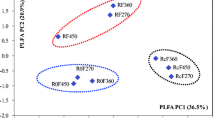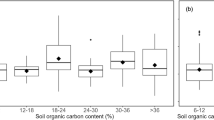Abstract
No-tillage (NT) management is a promising method to sequester soil C and mitigate global warming caused by agricultural activities. Here, we report 4 years of continuous soil respiration rates and weekly nitrous oxide (N2O) and methane (CH4) emissions in NT and conventional-tillage (CT) plots in a typical Japanese volcanic soil. Overall, the soil respiration, N2O emission, and CH4 uptake decreased significantly in the NT plot. A difference in soil respiration and N2O emission between the two plots began after the tillage treatment and the incorporation of crop residues and fertilizers, whereas the CH4 uptake did not vary significantly during the fallow period after the treatments. The N2O emission was higher from the CT than from the NT plot during the fall. The overall lower CH4 uptake in the NT than in the CT plot likely resulted from a combination of decreased soil gas diffusivity and higher mineral N content at the soil surface. Higher soil respiration and N2O emission occurred in the NT plot in the summer of 2003 and were plausibly caused by an increase in the soil moisture content that resulted from lower temperatures during July and August; the higher soil moisture must have accelerated the decomposition of organic matter accumulated in the topsoil. These results indicate that NT management is generally effective for the mitigation of the total GWP by reducing soil respiration and N2O emission in temperate regions; however, NT management may increase rather than decrease these emissions when fields experience cool summers with frequent rainfall.





Similar content being viewed by others
References
Akaike H (1974) New look at statistical-model identification. IEEE Trans Autom Control AC19(6):716–723. doi:10.1109/TAC.1974.1100705
Akiyama H, Tsuruta H (2003) Effect of organic matter application on N2O, NO and NO2 fluxes from an Andisol field. Glob Biogeochem Cycles 17:1100. doi:10.1029/2002GB002016
Alvarez R, Russo ME, Prystupa P, Scheiner JD, Blotta L (1998) Soil carbon pools under conventional and no-tillage systems in the Argentine rolling pampa. Agron J 90:138–143
Baggs EM, Stevenson M, Pihlatie M, Regar A, Cook H, Cadisch G (2003) Nitrous oxide emissions following application of residues and fertilizer under zero and conventional-tillage. Plant Soil 254:361–370
Ball BC, Scott A, Parker JP (1999) Field N2O, CO2 and CH4 fluxes in relation to tillage compaction and soil quality in Scotland. Soil Tillage Res 53:29–39
Choudhary MA, Akramkhanov A, Saggar S (2002) Nitrous oxide emissions from a New Zealand cropped soil: tillage effects, spatial and seasonal variability. Agric Ecosyst Environ 93:33–43
Cochran VL, Sparrow EB, Schlentner SF, Knight CW (1997) Long-term tillage and crop residue management in the subarctic: fluxes of methane and nitrous oxide. Can J Soil Sci 77:565–570
Ellert BJ, Janzen HH (1999) Short-term influence of tillage on CO2 fluxes from a semi-arid soil on the Canadian Prairies. Soil Tillage Res 50:21–32
Elmi AA, Madramootoo C, Hamel C, Liu A (2003) Denitrification and nitrous oxide to nitrous oxide plus dinitrogen ratios in the soil profile under three tillage systems. Biol Fertil Soils 38:340–348
Fender A-C, Pfeiffer B, Gansert D, Leuschner C, Daniel R, Jungkunst H (2012) The inhibiting effect of nitrate fertilization on methane uptake of a temperate forest soil is influenced by labile carbon. Biol Fertil Soils 48:621–631
Guntzer F, Keller C, Meunier J-D (2012) Benefits of plant silicon for crops: a review. Agron Sustain Dev 32:201–213. doi:10.1007/s13593-011-0039-8
Hodson MJ, White PJ, Mead A, Broadley MR (2005) Phylogenetic variation in the silicon composition of plants. Ann Bot 96:1027–1046. doi:10.1093/aob/mci255
Huang S, Sun Y-N, Rui W-Y, Liu W-R, Zhang W-J (2010) Long-term effect of no-tillage on soil organic carbon fractions in a continuous maize cropping system of Northeast China. Pedosphere 20:285–292
Hütsch BW (1998) Tillage and land use effects on methane oxidation rates and their vertical profiles in soil. Biol Fertil Soils 27:284–292
IPCC (2007) The physical science basis. Cambridge University Press, Cambridge
Kassavalou A, Mosier AR, Doran JW, Drijber RA, Lyon DJ, Heinemeyer O (1998) Fluxes of carbon dioxide, nitrous oxide, and methane in grass sod and winter wheat-fallow tillage management. J Environ Qual 27:1094–1104
Koizumi H, Usami Y, Satoh M (1993) Carbon dynamics and budgets in three upland double-cropping agro-ecosystems in Japan. Agric Ecosyst Environ 43:235–244
Lal R (2001) World cropland soils as a source or sink for atmospheric carbon. Adv Agron 71:145–191
Matsumoto N, Paisancharoen K, Hakamata T (2008) Carbon balance in maize fields under cattle manure application and no-tillage cultivation in Northeast Thailand. Soil Sci Plant Nutr 54:277–288
Mosier AR, Delgado JA, Keller M (1998) Methane and nitrous oxide fluxes in an acid oxisol in western Puerto Rico: effects of tillage, liming and fertilization. Soil Biol Biochem 30:2087–2098
Mummey DL, Smith JL, Bluhm G (1998) Assessment of alternative soil management practices on N2O emissions from US agriculture. Agric Ecosyst Environ 70:79–87
Nakadai T, Yokozawa M, Ikeda H, Koizumi H (2002) Diurnal changes of carbon dioxide flux from bare soil in agricultural field in Japan. Appl Soil Ecol 19:161–171
Ni K, Ding W, Zaman M, Cai Z, Wang Y, Zhang X, Zhou B (2012) Nitrous oxide emissions from a rainfed-cultivated black soil in Northeast China: effect of fertilization and maize crop. Biol Fertil Soils 48:973–979
Nishimura S, Sudo S, Akiyama H, Yonemura S, Yagi K, Tsuruta H (2005a) Development of a system for simultaneous and continuous measurement of carbon dioxide, methane and nitrous oxide fluxes from croplands based on the automated closed chamber method. Soil Sci Plant Nutr 51:557–564
Nishimura S, Swamoto T, Akiyama H, Sudo S, Cheng W, Yagi K (2005b) Continuous, automated nitrous oxide measurements from paddy soils converted to upland crops. Soil Sci Soc Am J 69:1977–1986
Nouchi I, Yonemura S (2005) CO2, CH4 and N2O fluxes from soybean and barley double-cropping in relation to tillage in Japan. Phyton 45:327–338
Oorts K, Merckx R, Grehan E, Labreuche J, Nicolardot B (2007) Determinants of annual fluxes of CO2 and N2O in long-term no-tillage and conventional tillage systems in northern France. Soil Tillage Res 95:133–148
Passianoto CC, Ahrens T, Feigl BJ, Steudler PA, do Carmo JB, Melillo JM (2003) Emissions of CO2, N2O, and NO in conventional and no-till management practices in Rondonia, Brazil. Biol Fertil Soils 38:200–208
R Development Core Team (2011) R: a language and environment for statistical computing. R Foundation for Statistical Computing, Vienna, Austria. URL http://www.R-project.org/
Rasmussen PE, Collins HP (1991) Long-term impacts of tillage, fertilizer, and crop residue on soil organic matter in temperate semiarid regions. Adv Agron 45:93–134
Reicosky DC (1997) Tillage-induced CO2 emission from soil. Nutr Cycl Agroecosyst 49:273–285
Sakamoto Y, Ishiguro M, Kitagawa G (1986) Akaike Information Criterion Statistics. D. Reidel Publishing Company, Dordrecht
Six J, Ogle SM, Breidt FJ, Conant RT, Mosier AR, Paustian K (2004) The potential to mitigate global warming with no-tillage management is only realized when practiced in the long term. Glob Chang Biol 10:155–160
Togami K, Nakai S, Yonemura S (2009) Accumulation of soil organic carbon and changes in soil properties with no-tillage practice. Dojohiryo Gakkaishi 80(4):511–515 (in Japanese)
West TO, Marland G, King AW, Post WM, Jain AK, Andrasko K (2004) Carbon management response curves: estimates of temporal soil carbon dynamics. Environ Manag 33:507–518
Yazaki T, Nagata O, Sugito T, Hamasaki T, Tsuji H (2011) Nitrous oxide emissions from an Andosol upland field cropped to wheat and soybean with different tillage systems and organic matter applications. J Agric Meteorol 67:173–184
Yonemura S, Kawashima S, Tsuruta H (1999) Continuous measurements of CO and H2 deposition velocities onto an andisol: uptake control by soil moisture. Tellus 51B:688–700
Yonemura S, Kawashima S, Tsuruta H (2000a) Carbon monoxide, hydrogen, and methane uptake by soils in a temperate arable field and a forest. J Geophys Res 105:14347–14362
Yonemura S, Yokozawa M, Kawashima S, Tsuruta H (2000b) Model analysis of the influence of gas diffusivity in soil on CO and H2 uptake. Tellus 52B:919–933
Yonemura S, Yokozawa M, Shirato Y, Nishimura S, Nouchi I (2009) Soil CO2 concentrations and their implications in conventional and no-tillage agricultural fields. J Agric Meteorol 65:141–149
Acknowledgments
This study was principally supported by the project "Elucidation of Vulnerability in Agriculture, Forestry and Fisheries to Global Warming and Development of Mitigation Techniques," which was funded by the Ministry of Agriculture, Forestry and Fisheries from 2002 to 2005, and partly supported by a KAKENHI grant (23310017). We thank Mr. T. Suzuki, Mr. T. Ara, Mr. T. Kamata, Mr. I. Iino, Mr. T. Okada, Mr. H. Wakabayashi, Ms. I. Utagawa, and Ms. M. Ootsuji of the NIAES for their assistance with the fieldwork, the closed-chamber measurements, and the gas analyses. We also thank Dr. M. Du of the NIAES for data collection in the field during 2003 when S.Y. was a research fellow in Germany and not present at the NIAES.
Author information
Authors and Affiliations
Corresponding author
Rights and permissions
About this article
Cite this article
Yonemura, S., Nouchi, I., Nishimura, S. et al. Soil respiration, N2O, and CH4 emissions from an Andisol under conventional-tillage and no-tillage cultivation for 4 years. Biol Fertil Soils 50, 63–74 (2014). https://doi.org/10.1007/s00374-013-0831-5
Received:
Revised:
Accepted:
Published:
Issue Date:
DOI: https://doi.org/10.1007/s00374-013-0831-5




